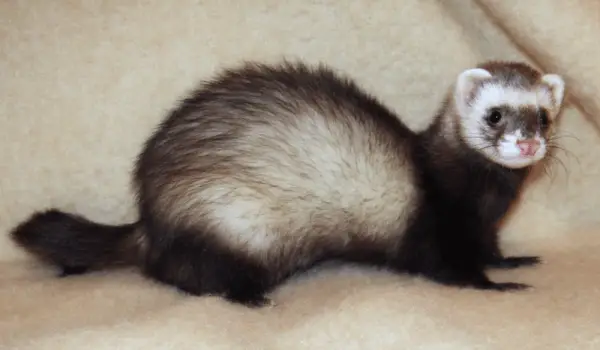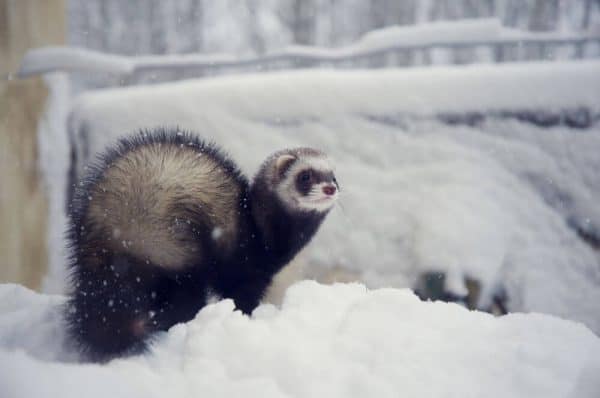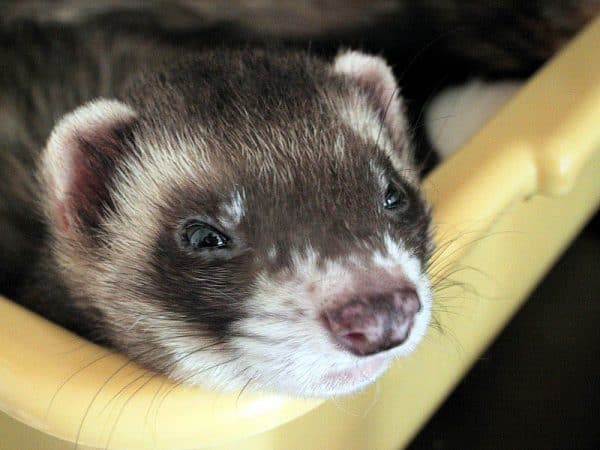By Fur Length – 3 Types
With short or long fur, with or without an undercoat (Angora), there are 3 different types of ferrets if you go by fur length.
Standard or Short Fur
The standard version of the ferret, the type easiest to find, is the one with short fur.
In some cases, even short fur ferrets will have longer hair come winter time.
It’s the one that you’re likely to find at pet shops, and it should do fine for most owners of ferrets.
Long Fur Ferrets
A version with longer fur also exists, though the difference may not be as big as you might imagine.
Still, if you want something that will likely do better during winter months, this one could be it.
Make sure it’s an actual long fur ferret, and not the Angora variant, and that it has an undercoat.
The undercoat is a secondary fur coat, short and dense, which helps protect the animal from cold.
Sporting a coat with a length of 2-4 inches (5-10 cm), it might seem to some that the Angora version is the same as the long fur one.
There is a big difference between the two though, and that’s whether the undercoat is present.
In the case of the Angora ferret, it will not have that undercoat.
This makes it more susceptible to cold, during the winter months.
By Color and Pattern – 20 Types of Ferrets
When it comes to color and pattern, you will find that there is a lot of different options.
We’ve grouped color and pattern together, and there are 20 different variants in total.
Albino Ferrets are going to stand out anywhere. In some cases, we’re just talking about ferrets that are aging or shedding, if the white fur is the only one that stands out.
Their pretty all-white fur is possible because of albinism. It means that they can’t produce pigments, and it’s a genetic trait.
The combination between the solid white fur and the pink nose and pink/red eyes is one that makes many prefer them.
Unfortunately, Albino ferrets are more likely to become deaf as well. They adapt to this condition with ease though.
This particular type will often make for good therapy pets, both for children and the elderly.
A ferret of the black sable variety has a dark-colored guard, while the undercoat is going to be gold brown or white.
Expect to find a dark brown nose and eyes of the same color.
A dark mask-like area is going to be visible above the nose, which resembles the mask of Zorro in form.
Black Sable Mitts Ferrets
In a lot of ways, the Black Sable Mitts Ferrets will have the same look as their cousins.
The difference is mentioned in their name, and it’s going to come from the color of their feet.
While the rest of their fur will be black or dark brown, their mitts will be completely white. The same color is on their chest.
This gives them a distinctive look, that some may go for.
The name of the Blaze Ferret comes from a white stripe of fur that goes from the top of the head, to the back.
The stripe is the common element, along with white mitts on the feet and a white bib on the chest. The rest of the fur can come in different colors.
If you check out their eyes, you will also notice the ring-like shape around them.
The color of the Champagne Ferret is lighter, as expected. It’s still brown, but a much lighter shade. Some will call this a diluted chocolate shade.
The undercoat is white or cream. Eyes are brown, pink or dark red (burgundy), and they can have rings of different colors around them.
Chocolate-colored ferrets are easy to find, being one of the common versions.
Its fur color resembles that of chocolate, so it’s a dark brown that everyone will recognize.
As for its undercoat, it will have a lighter color, either wheat or cream like.
The eyes of a Chocolate ferret will be dark red or black.
The nose is brown or pink.
Chocolate Mitts Ferrets
If you like what you’ve read about the Chocolate ferret, the version with chocolate-colored mitts will also be interesting.
It’s the same in most respects, but it has the mitts of the same color as the guard hairs.
A Cinnamon ferret has red-brown hairs, with the face mask Cinnamon-colored. Its legs tend to be of a darker color than the rest of the body.
It typically has a pink nose, while the outline is orange.
It’s not going to be easy finding one, as the Cinnamon ferret is rare, the least common of all colors.
This means that it’s going to be more expensive, while the typical common ferrets are quite cheap ($50-$100).
Cinnamon Mitts Ferrets
If you like the Cinnamon ferret, but you want something even more special, then the version with mitts of the same color might be it.
The only difference between them, will be the color of the mitts.
It’s rare, even more so than the regular version.
The name is pretty much self-explanatory. The Dalmatian Ferret will resemble the popular dog breed.
It is a white-colored animal, which has black spots on its fur coat.
It’s rare to find Dalmatians which are of a different color.
Other notable traits include its black or dark red eyes, along with a pink nose.
Not quite as common as some of the others, the Silver/Pewter style Ferret is going to impress with its look.
The predominant color is grey, but you will find black hair in its fur as well.
It can have a pink nose, which will sometimes contain black spots on its surface.
While you shouldn’t expect the Panda Ferret to look like an actual Panda Bear, there will be a resemblance in the way it’s colored.
You will find that it has dark circles around the eyes. It also has a white bib underneath, and the same color can be found on its shoulders and head as well. Even the tip of the tail will be of that color.
You will also notice that its four mitts are of a different color than the rest of the limbs.
A major downside with the Panda Ferret, is that on average 75% of them are deaf. Waardenburg Syndrome is responsible.
You will find that this is a very common type of ferret, which has a solid dark coat. A golden or cream undercoat (sometimes dark) is present.
The Sable ferret also has black or brown eyes, while the nose is black.
Regular Sable Mitts Ferrets
As with other ferrets, the Sable Mitts version has different colors for the four mitts. Otherwise, it’s the same as the regular Sable Ferret.
It has a more distinctive look, thanks to those mitts, and if you don’t want the same look as everyone else, it makes sense to look for a Sabble Mitts ferret.
Light pattern Ferrets
The overall impression is that these ferrets have a light-colored coat. White colored typically, it will incorporate random dark hairs in different spots. It doesn’t ruin the impression of a light-pattern ferret though.
The eyes will be dark red, while the nose is pink or black.
Medium pattern Ferrets
It’s the version of the light pattern ferret that will incorporate more dark hairs. It’s still not considered a dark pattern though, you get more white than black.
The name is borrowed from the Siamese cat, so you might be familiar with its look already.
The color is either Sable, Cinnamon or Chocolate, and there will be dark-colored limbs. The underside is darker as well.
The V shape of the mask is another distinctive element.
Siamese Mitts Ferrets
Once again, you have the regular Siamese ferret, but with differently colored mitts. It’s going to be rarer than the regular Siamese.
Another distinctive ferret, which gets its name from the dark-colored line that goes across its white coat. It goes all the way to the tail.
The eyes are colored pink or dark red, while the nose is black or pink.
If you want a white ferret, the DEW version might be better than the Albino. It doesn’t have the same issues with the lack of pigmentation, it’s just completely white. In some cases, it might have a couple of dark hairs around the backbone.
At the same time, their eyes are black. The nose is either pink or black.
As with the Albino, it’s going to have a higher chance of being deaf.
Ferret Coat Grooming Tips
Some will also remove the anal glands, the ones that it uses to deliver secretions with strong smells. It’s not recommended by all doctors though, and they use them only if they get scared, so you may consider leaving them.
You don’t need to bathe the ferret often, it will not help with the odor. It might actually make it worse, if you bathe it too often. Once or twice per year will be enough, or if it gets dirty.
Luckily, they’re like cats when it comes to cleaning, meaning that they will do it themselves.
If you do bathe them, make sure that you’re using a shampoo that is pet-friendly, and you do it with slightly warm water.
Conclusion
As you can see, there are a lot of different options for you to choose from. Some may not be easily available in your area, or they’re just rare in general. Others might have potential issues with deafness or blindness, so there are those to consider as well.
Whatever your choice may be, the ferret is going to be an excellent pet to have around. It’s not as easy as having a cat, but each pet has its own pros and cons.




